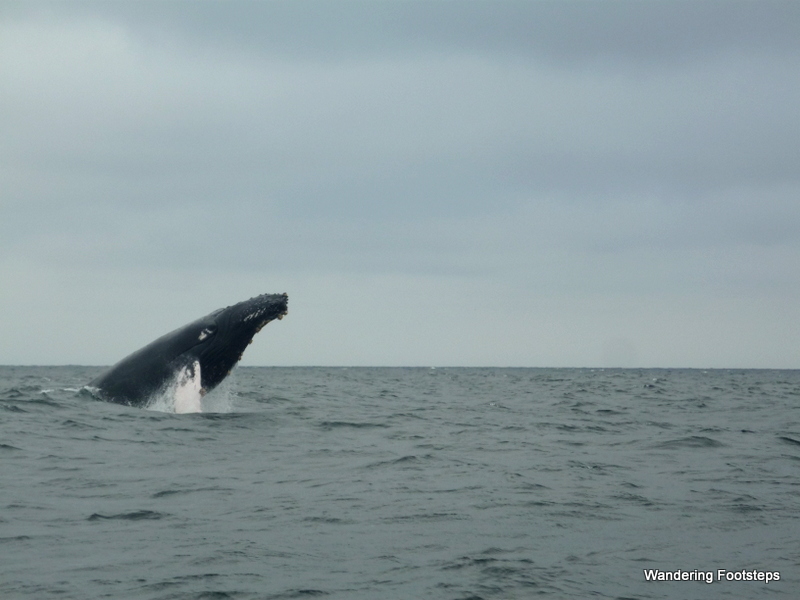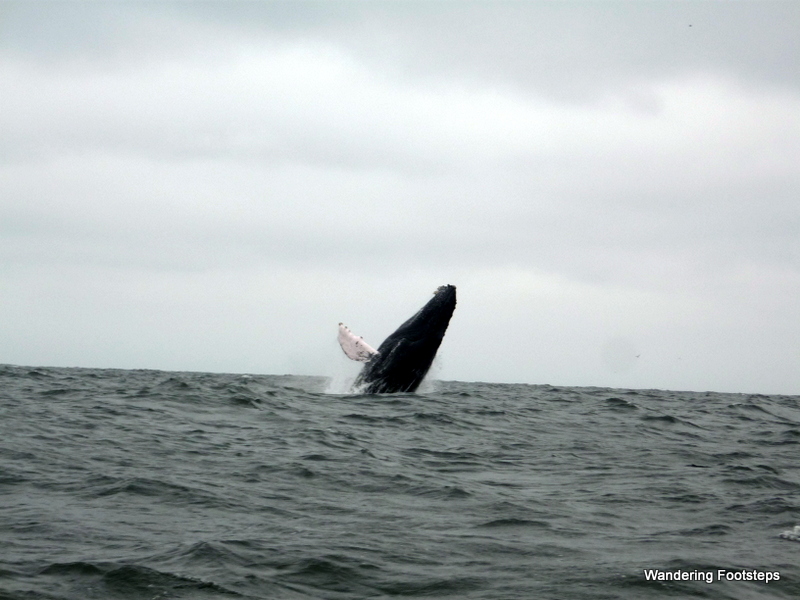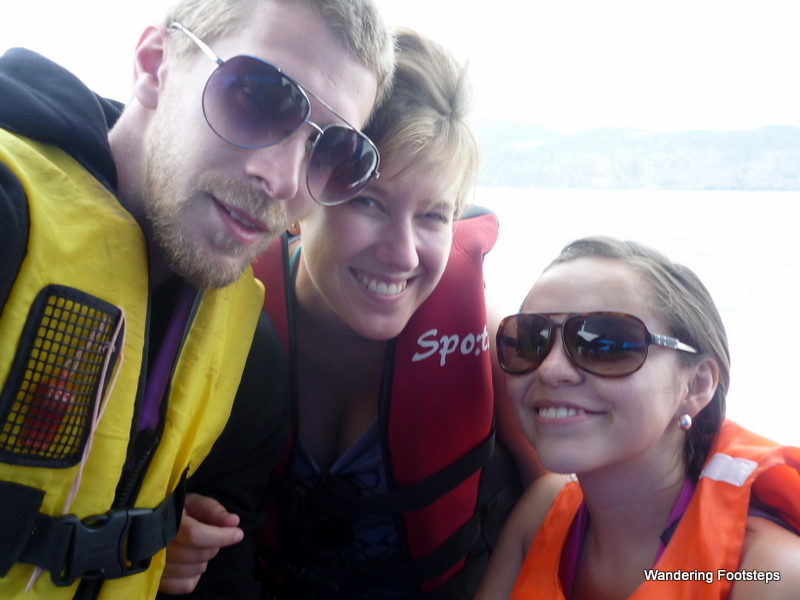I love whales.
Of all the animals that I have had the fortune of seeing firsthand – which, I am privileged to say, is a lot – whales top the list. I think it’s that, despite their size, they are gentle and graceful, and totally mysterious.
I began falling for whales the summer I got to see orcas in the Juan de Fuca Strait off the coast of Victoria, B.C. It was my first time observing wildlife in their natural habitat, and my dear mother and I were in awe of the calls of mating whales surrounding our zodiac.
I fell flat-faced head-over-heels for whales when I got up close to humpbacks off the coast of Ecuador. My brother, his girlfriend, and I were returning from the “Poor Man’s Galagapos,” when a humpback approached our little motor boat and proceeded to swim along with us, crashing repeatedly into the water and showing us her ridged underside. She was so close I could see the barnacles on her body, and I distinctly recall the eye on the side of her head – it appeared to be looking straight at me.

One of two shots I managed with my crappy camera of this amazing event.

One of the most awesome sights I’ve ever witnessed.

Three super happy campers.
It was no surprise, then, that when I learned that, in summer, we could see beluga whales in Quebec’s Fjord du Saguenay, or any of thirteen species of whale in the Saint Lawrence River, I was in!
The logical place to begin our whale-watching adventure was Lac St-Jean, which drains into the St. Lawrence River via the Saguenay River. Though no whales reach even close to this lake, it’s a scenic, mostly flat, agricultural region famous for its blueberries and its 250km-long bike path around the lake. As with all good searches, it’s important to take advantage of all a region has to offer.
Unfortunately, rain arrived at the same time as we did, and the thick grey clouds made clear that it was here to stay. So we didn’t. That’s one of the many advantages of having a home-on-wheels and no fixed schedule.

On the Whale Route!

Thunderstorm blowing in over Lac St. Jean.

Beautiful rainbow, but a mere brief respite from endless rain.
Instead, we continued onward to the fjord itself. When I think of fjords, I think of Scandinavia, though the only fjord I’ve actually seen with my own eyes was off the coast of Oman’s Musandam Peninsula. It turns out that a fjord is simply a long and narrow inlet of the sea, carved by glaciers, with high cliffs and deep waters. At over 100km long, the Fjord du Saguenay is one of the longest in the world, and the only navigable fjord in North America.
We got to try navigating these waters ourselves – in kayaks! It wasn’t easy to organize, because all kayak rentals on the fjord are via guided tours – apparently the current and wind on the water are unpredictable. As a seasoned kayaker, this wasn’t appealing to me, and I set to work searching for a way around this rule. In St. Rose du Nord, a charming village set in a narrow, steep valley on the edge of the river, I managed to find two locals who agreed to rent us their kayaks for a couple hours. Score! Bruno and I set to the water, where we were able to explore the rugged coastline from the sea. The wind did pick up halfway through our ride, and it was, indeed, fierce – especially when a surprise storm rolled in – but it was nothing a strong paddle and a maple-butter ice cream cone couldn’t handle!

Navigating the fjord du Saguenay by kayak!

Meet Brittany, the serious kayaker.

Meet Bruno, the professional ice-cream eater.
Its navigability is not what makes the Fjords of Saguenay so special, though – it’s the whales. Whales flock in crazy numbers to feed on the gigantic quantity of krill that can be found at the mouth of the fjord. The reason for the masses of krill are complex, but, basically, it has to do with the warm waters of the fjord merging with the ice-cold water of the St. Lawrence River (and a bunch of other factors that I’m not sure I truly understand).
Because of my lack of understanding, I thought at the time that there were whales along the entire 100km-length of the Fjord du Saguenay. We’d been straining our eyes to see them out on the water for days, to no avail. In fact, it wasn’t until we approached the St. Lawrence River itself that we would actually stand a chance of spotting a whale – and only the belugas.
That would have been fine by me. Of the thirteen species of whales present in Quebec, only the beluga whale is a permanent resident. The cold water-loving beluga whale is a true resident of the St. Lawrence. Sadly, they are now an endangered species (numbering about 900) and are thus a rare enough sight. The high levels of pollution in the water, though much-improved in the last decade or two, have caused a lot of unnecessary beluga deaths. But their numbers had already been decimated, since, until the 1960s, the Canadian government paid a loonie ($1) for each beluga head, believing these fish-lovers to be the reason for the collapse of the fishing industry in the St. Lawrence.
Alas, we did not spot any beluga whales in the Fjords du Saguenay. But we did get to witness a few expansive viewpoints from the tops of its tree-filled cliffs.

A 10-minute uphill hike rewarded us with this view of the fjord.

Inland, it’s all hills and valleys and forests.

One of our boondocks along the fjord.
It was in Tadoussac that I became more confident in our whale-spotting chances. The once-humble town is now a major tourist industry centered upon a single thing – whales. A half-dozen whale-watching companies operate in the town, and you can buy whale-watching tickets at every dépanneur (corner store) or souvenir shop on the block.
I personally wasn’t planning on boarding a zodiac in Tadoussac – I’d read more affordable companies operated out of the nearby towns. But, just being in a place so self-assuredly built around whales made me more certain we were on the right track.
As it was a lovely sunny day, and Tadoussac had that typical Quebec town charm – with colourful, tastefully-renovated old country homes, French-inspired gourmet cuisine, and the wonderfully nasal Quebec French accent – Bruno and I decided to make a day of it. We wandered along the beach front, our toes in the relatively warm water; we visited the oldest chapel in all of Canada, perched along Tadoussac’s protected bay; and we had a fabulous lunch on the terrace of Café Bohème.

The oldest chapel in all of Canada.

Seriously cute homes in Quebec, right?

OMG this lunch was so exciting!
We also found a great place to camp for a couple nights. A few kilometers east of town are giant sand dunes overlooking the St. Lawrence River. Mercifully, Quebec is a wonderful place to boondock, and there were no signs here forbidding overnight stays. We parked our bus on the edge of the dunes with a 180-degree view of the water, and I sat all afternoon at the top of the dune, gazing out into the water and soaking in the summer’s first true rays of sun. I almost didn’t even need to see whales.

Me, loving life at the top of a sand dune overlooking the St. Lawrence River.

You see that big sand dune right there? Yeah, at the top of it is where we camped. Score!
Who am I kidding? Of course I needed to see whales! I wanted to see belugas, blue whales, right whales, humpbacks, porpoises, and all the other species of whales in the river I’d not yet heard of.
And so, we drove onward, toward Les Escoumins. On the way, we saw a sign for Cap Bon Désir, with symbols of picnic tables and viewpoints. Since it was lunchtime, we turned in. Thank goodness we did, for here, unbeknownst to us, was the best site along the St. Lawrence to see whales from ashore!
This was the kind of place where Bruno sets up shop for the day. I’d witnessed this on our safaris in Africa – he’d find a water hole or a hide that looked both promising and relaxing, grab snacks, water, a camera, binoculars, and a book, and that would be it. Our day was planned – we would chill there, waiting for the animals to come to us.
This is thus what we did at Cap Bon Désir – we grabbed all the items listed above (as well as many extra layers of clothing – the temperature of the St. Lawrence here is 4 degrees year-round and we were on a rocky cliff jutting out into the water) and made ourselves comfortable.
Within fifteen minutes, two minke whales had come right up to the rocks and shown us brief glimpses of their fins before diving deep down and disappearing. I began to think maybe I wouldn’t have to jump on a zodiac at all – the whales would just come to me! Over the following five hours, however, I learned that it was only the minke whales – the most common whales of the St. Lawrence – who exhibited this gregariousness. All other whale species were much further out – indeed, we occasionally spotted water shooting up from blowholes next to a zodiac far out at sea.
I needed to be in that zodiac.

Sat waiting for the whale show at Cap Bon Desir.

We saw a minke whale pretty darn close to the coast!

Another minke whale showed us its belly.

Mostly, though, Bruno took photos of sea gulls.
The following morning, we lined up with fifty other tourists at the pier of Croisières Escoumins and boarded one of two zodiacs. Admittedly, it felt slightly odd to be joining such a mass of people on such a tourist activity, but desperate times call for desperate measures. It was a gorgeous, calm morning, and a perfect day for a boat trip, but we were nonetheless advised to dress in layers, and we were each given a heavy winter parka to wear on top. I was soon very grateful for these layers, because a 4-degree wind at fifty miles an hour sure is cold!
But I was happy. I feel good on the water. My senses were on hyper-aware mode and I scanned the water for any sign of movement. Admittedly, since water moves, distinguishing a wave from a whale isn’t easy.
But it is easy to spot belugas. And spot them we did! Twenty minutes into our tour, we caught sight of bright white masses popping out of deep blue waters. They were far off, and, because of their status, our boat couldn’t legally approach them, so the captain cut the engine and we watched and waited. It wasn’t long before we were surrounded on all sides by beluga whales, for they travel in large groups. As if this weren’t special enough, a group of three of them crossed immediately in front of our boat before swimming gracefully past the other side. Boy, am I ever lucky with whales!

Beluga whales, approaching our zodiac!!

Even far away, belugas are easy to distinguish from the blue water.

Super happy to be out on the water and surrounded by whales! (Thank you, mom and dad, for the birthday gift!!)
During the rest of the ride, we spotted porpoises, seals (they have few predators here since orcas come only in small numbers), and a massive group of minke whales feeding at the mouth of the fjord (a rare sight since they are solitary whales). The blue whales hadn’t yet arrived to the St. Lawrence that year, and all the whales were so busy eating that we didn’t see much more than backs and fins quietly glide along the surface, but being surrounded by these mythical creatures was as touching as my other two whale encounters.

Another close-up glimpse of minke whales, this time from the water. I think there’s a seal head bobbing in the background.

This is the most “out of the water” shot we got.
It was also sad. For me, the whales’ history is such a tragic one. Whale-hunting, overfishing, habitat destruction, crashes with boats – it seems almost a miracle that these ancient creatures have managed to survive at all. The right whale, which occasionally visits the St. Lawrence, was hunted to near-extinction because it floats when it’s dead, making it easy to recover. As we watched belugas in the St. Lawrence, seven floating bodies were being recovered in the Gulf of St. Lawrence. Usually, that amount of right whales were discovered in an entire season, and no one was quite sure why so many had perished in a matter of days.
Maybe the reason I love whales so much is this: they are as old as time, and a testament of the resilience of Nature. They exist almost invisibly to us, revealing of themselves mere glimpses to those with a bit of patience and luck. They remind us that a moment cannot be captured or held onto, and that its greatest beauty lies in its ability to swim free.



Auntie Freya - Brittany and Bruno, Keep the blogs coming. I so enjoy them.
Love, Freya